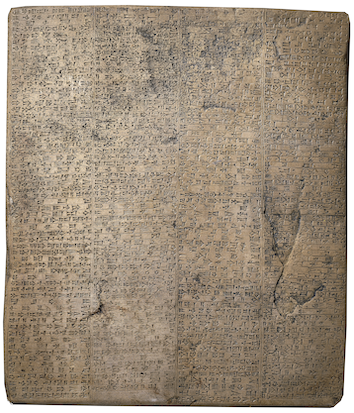Ezida (cella of Nabû in Esagil at Babylon)

Ezida, which was dedicated to the god Nabû, was the third most important cult room in the main building of Esagil. Its main gate was Kaezida. The only ruler known to have worked on this part of Babylon's principal temple, which was situated in the as-of-yet-unexcavated southwest corner of the building, is the Neo-Babylonian ruler Nebuchadnezzar II (r. 604–562 BC). Nabû used this part of the temple when he visited Babylon during the New Year's festival (Akkadian akītu).
Names and Spellings
Like his main temple at Borsippa, the Sumerian ceremonial name of Nabû's cella in Esagil was Ezida, which means "True House." Inscriptions of Nebuchadnezzar II sometimes refer to it as "the seat of the god Lugaldimmerankia (and) the cella of the Nabû on the courtyard" (Akkadian šubat lugaldimmerankia papāhi nabû ša kisallam); here, Lugaldimmerankia is a name of Nabû that he borrowed from his father Marduk. The main entrance to this part of Esagil was called Kaezida, the "Gate of Ezida."

BM 129397, a large stone tablet that bears a long Akkadian inscription that is now commonly referred to as the "East India House Inscription." The description of Nebuchadnezzar's decoration of Kaezida, the principal gate of the god Nabû's cella in Esagil, is recorded in lines ii 51–53. Image adapted from the British Museum Collection website. Credit: Trustees of the British Museum.
- Written Forms: e₂-zi-da; ka₂-e₂-zi-da.
Known Builders
- Neo-Babylonian (ca. 625–539 BC)
- Nebuchadnezzar II (r. 604–562 BC)
Building History
During his work on the main building of Esagil, the Neo-Babylonian ruler Nebuchadnezzar II renovated Ezida, together with Eumuša: (the cella of Marduk) and Kahilisu (here used as the name of the goddess Zarpanitu's cella Edara'ana). Several Akkadian inscriptions of his, including one written on a large stone tablet (the so-called "East India House Inscription") and a few written on rock faces in Lebanon, record that he decorated this Ezida's door-jambs, door bolts, and giškanakkus (exact meaning uncertain) — including those of its main entrance Kaezida — with gold and made that holy room shine like daylight.
Archaeological Remains
The rooms in Esagil associated with Nabû are located in the southwestern corner of the main part of Esagil, northwest of Ka-ude-babbara (= Gate B), southwest of the Court of Bēl (the central courtyard of the main part of Esagil), and south of Eumuša (the cella of the god Marduk). Because this part of Babylon's principal temple is still largely unexcavated, Ezida has not yet been positively identified in the archaeological record.
Further Reading
- George, A.R. 1992. Babylonian Topographical Texts (Orientalia Lovaniensia Analecta 40), Leuven, pp. 281–282.
- George, A.R. 1993. House Most High. The Temples of Ancient Mesopotamia (Mesopotamian Civilizations 5), Winona Lake, p. 160 no. 1237.
- George, A.R. 1995. "The bricks of E-sagil," Iraq 57, pp. 173–197.
Banner image: areal photograph of the excavation pits and trenches in the area of the remains of Esagil and Etemenanki taken in 1923 (left); a reconstruction of Esagil and Etemenanki during the reign of the Neo-Babylonian king Nebuchadnezzar II (center); a plan of Esagil, and Etemenanki (right). Images from O. Pedersén, Babylon: The Great City, pp. 144–145 figs. 4.3–4.4 and p. 151 fig. 4.11.
Jamie Novotny
Jamie Novotny, 'Ezida (cella of Nabû in Esagil at Babylon)', Babylonian Temples and Monumental Architecture online (BTMAo), The BTMAo Project, a sub-project of MOCCI, [http://oracc.org/btmao/Babylon/TemplesandZiggurat/Esagil/RoomsandGates/Ezida/]